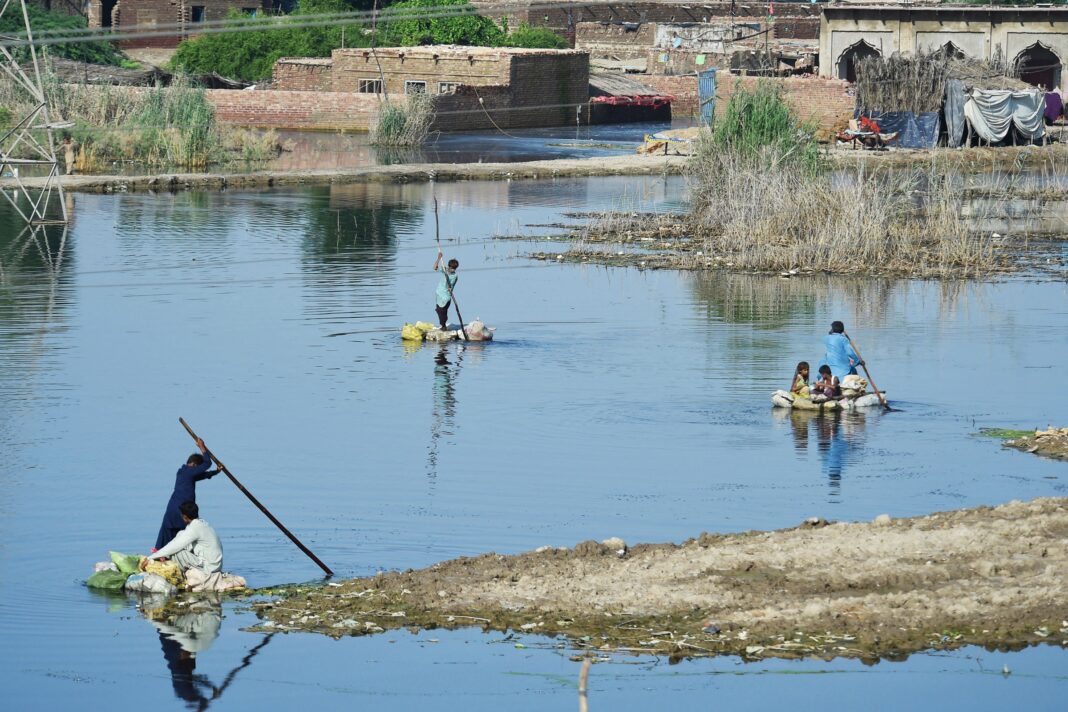This story originally appeared in The Guardian and is part of the Climate Desk collaboration. The climate crisis is the prime suspect for the devastating scale of flooding in Pakistan , which has killed more than 1,000 people and affected 30 million. But the catastrophe, still unfolding, is most likely the result of a lethal combination of factors, including the vulnerability of poor citizens, steep mountainous slopes in some regions, the unexpected destruction of embankments and dams, and some natural climate variation.
The horrific scale of the floods is not in doubt. “We are witnessing the worst flooding in the history of the country,” said Fahad Saeed, a climate scientist with the Climate Analytics group, who is based in Islamabad. The obvious cause is the record-breaking rainfall.
“Pakistan has never seen an unbroken cycle of monsoon [rains] like this,” said Sherry Rehman , Pakistan’s climate change minister. “Eight weeks of nonstop torrents have left huge swathes of the country underwater. This is a deluge from all sides.
” She said the “monster monsoon was wreaking nonstop havoc throughout the country. ” From the beginning of the month, the rainfall was nine times higher than average in Sindh province and five times higher across the whole of Pakistan. Basic physics is the reason rainfall is becoming intense around the world—warmer air holds more moisture.
Scientists are already trying to determine the extent to which global heating is to blame for the rainfall and floods. But analysis of the previous worst flood in 2010 suggests it will be significant. That “superflood” was made more likely by global heating, which drove fiercer rains.
Warmer oceans and heating in the Arctic were implicated in the 2010 superflood, one study found, as these factors affected the jet stream, a high-level wind that circles the planet. The greater meandering of the jet stream led to both the prolonged rain in Pakistan and an extreme heat wave in Russia that year. And according to a 2021 study global, heating is making the south Asian monsoon more intense and erratic , with each 1 degree Celsius rise in global temperature leading to 5 percent more rain.
Pakistan has suffered regular flooding since 2010, as well as heat waves and wildfires. “Climate change is really affecting us,” said Saeed. “It has become a norm now that every year we kind of face extreme events.
” The current floods would have been expected less than once a century, according to Liz Stephens, an associate professor of climate risks and resilience at the University of Reading, UK, who is part of a global flood forecasting system. “We can see it is very extreme flooding and, in many places, it will be worse than 2010, when the floods killed 1,700 people. ” Two critical factors in the high death toll are flash flooding and the destruction of river embankments, Stephens said.
Some of the intense rains have hit places where the water rapidly runs off steep slopes. “Flash flooding is very difficult to provide good warning for and to get people out of harm’s way quickly,” she said. River embankments have also been destroyed.
“You can’t predict when they are going to fail, and people living in an area where they think they’re protected might not expect that they need to evacuate. ” Stephens said: “We’re talking about potentially unprecedented volumes of water—it would have been inconceivable that some parts of these catchments would have been affected. People don’t prepare for risks that they are not familiar with.
” Deforestation could also have increased the speed of rain runoff in places, Stephens said, while Saeed said dams had been destroyed on the Kabul River that runs into the Indus. A natural climate cycle driven by temperature and wind variations in the Pacific may also have added to the Pakistan floods, said meteorologist Scott Duncan. The El Niño–Southern Oscillation (ENSO) appears to be in its La Niña phase, as it was in 2010.
“La Niña is behaving very strongly in some metrics and is a significant factor for enhancing monsoonal rains, in my opinion,” he said. However, how global heating affects ENSO is not currently well understood. The population of Pakistan is especially at risk from extreme weather driven by the climate emergency, ranked eighth most at risk in the world by the Global Climate Risk Index.
“Pakistan is very vulnerable to extremes, and the whiplash from unprecedented heat from March to May this year, followed by a strong monsoon, makes the impact on society and the economy even more severe,” said Duncan. The extreme heat wave suffered earlier in 2022 was made 30 times more likely by global heating , and another heat wave in 2015 was also exacerbated by global heating . “What you see today is just a trailer of what’s in store for us with poverty, hunger, malnutrition, and disease if we don’t pay heed to climate change,” said development and climate expert Ali Tauqeer Sheikh.
The only silver lining in the current flooding situation is that it may not grow even more catastrophic. “Thankfully, no further significant rainfall is expected over the coming days as the end of the monsoon season nears,” said Nicholas Lee at MetDesk . However, it is clear that the climate crisis is supercharging the toll of extreme weather across the globe, even with just 1.
1 Celsius of global heating to date. Pakistan is the latest country where lives and livelihoods are being lost. “It’s a real planet SOS here,” said Rehman .
.
From: wired
URL: https://www.wired.com/story/pakistans-monster-monsoon-shows-the-wrath-of-climate-change/



